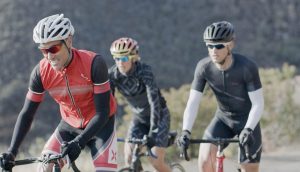By: Dr. Bob Murray, Managing Principal at Sports Science Insights and advisor to HOTSHOT
Muscle cramps are simple enough to those athletes who experience them regularly. When even a small muscle suddenly and painfully knots up, we either hobble along hoping for relief or stop what we're doing and scream, swear, stretch, and massage until the cramp subsides. We know from experience that muscle cramps immediately impair muscle function and either slow or stop training and racing. For athletes, muscle cramps are a simple problem in need of a simple solution. But for scientists, muscle cramps are still somewhat of an enigma, a not-so-simple phenomenon that afflicts millions of people.
For many years, sports scientists have debated whether exercise-associated muscle cramps--EAMCs for short--are caused by factors such as dehydration and salt loss that directly affect muscle function or by other factors that influence the function of the nerves that control muscles. New research findings raise the possibility of a third theory, one that settles the debate by unifying the two camps under one banner: EAMCs are caused by hyperactive motor nerves.
Motor nerves--also called alpha motoneurons--extend from the spinal cord to the muscles, allowing for both conscious and reflex control of muscle contraction. Large skeletal muscles are typically innervated by hundreds of motor nerves, with each motor nerve connected to hundreds of individual muscle cells. When a single motor nerve fires, all of its individual muscle cells contract simultaneously. The muscle twitching that athletes often experience prior to a full-blown muscle cramp may be caused by one or a few motor nerves misfiring, whereas a muscle cramp appears to be caused by the continuous firing of multiple motor nerves. In other words, the nerves become hyperactive, firing continuously and causing a sustained cramp until something intervenes to restore normal nerve function.
The theory that hyperactive motor nerves are responsible for EAMCs explains why so many different predisposing factors may be involved. Dehydration, salt loss, heat stress, muscle damage, muscle fatigue, poor fitness, reduced blood flow, and low muscle glycogen could all increase the risk of cramping by disrupting the normal function of motor nerves. How might that happen? The answer likely lies in the interplay between motor and sensory nerves. In addition to the motor nerves that control muscle contraction, there are many other nerves that deliver information from the muscles to the spinal cord and brain. In fact, two-thirds of all nerves associated with muscles are sensory nerves that keep the brain appraised of factors such as muscle length, tension, temperature, and chemical environment.
Constant input from sensory nerves modifies the function of motor nerves. Whenever we're fit, well hydrated, and pacing ourselves properly, motor nerves and sensory nerves communicate seamlessly, optimizing neuromuscular function. But when the system is disturbed for some reason--if we become dehydrated and hot, for example--feedback from sensory nerves increases, sometimes to the point that some motor nerves become hyper-excited and their normal function is disrupted, resulting in a cramp.
Preventing and treating EAMCs begins and ends with the nerve. First, athletes should always do the right things with hydration, nutrition, training, and pacing to reduce the risk factors that contribute to cramping. But sometimes doing all the right things still isn't enough to keep cramps at bay. When a bad cramp does strike, we know that stopping and stretching is usually effective at ending the cramp. Stretching a cramped muscle increases inhibitory signals from the muscle to the spine that quiet the hyperactive motor nerves. But no athlete wants to cramp in the first place, let alone have to stop and stretch. Recent research has shown that the proprietary formulation of organic ingredients in HOTSHOT can prevent muscle cramps by helping to maintain the normal function of motor nerves, preventing the hyperactivity that is associated with cramping.
Bottom line: HOTSHOT activates TRP channels in the sensory nerves in the mouth that send signals to the brain and spinal cord to inhibit hyperactive motor nerves, controlling Neuro Muscular Performance and preventing and treating muscle cramps. Learn more about TRP channels here.
MORE ON THE HOTSHOT BLOG
8 Questions with Champion Marathoner & HOTSHOT Ambassador Amy Hastings: Nutrition tips, HOTSHOT and more. Read on.
From the track to the marathon: Shalane Flanagan talks about her running career with HOTSHOT.
The Nerve is the Boss of the Muscle: Take control with HOTSHOT. Learn more.

